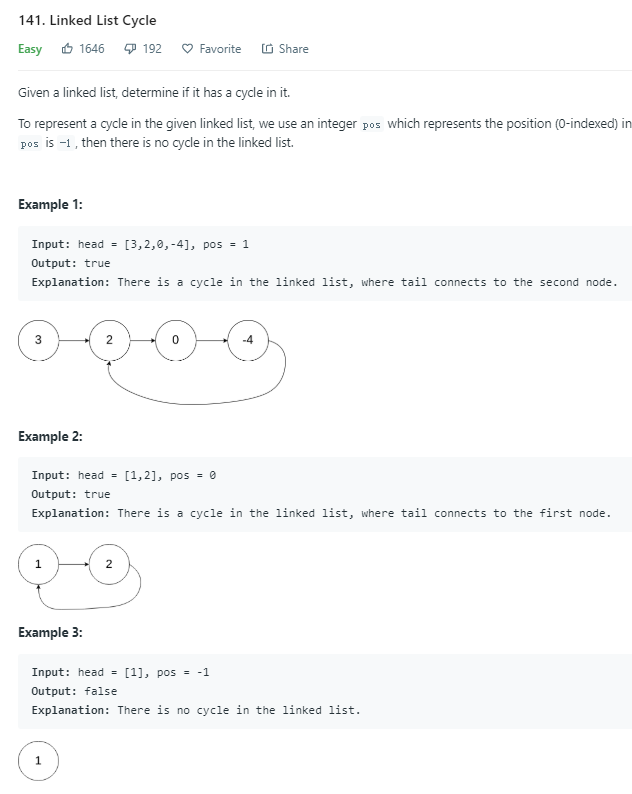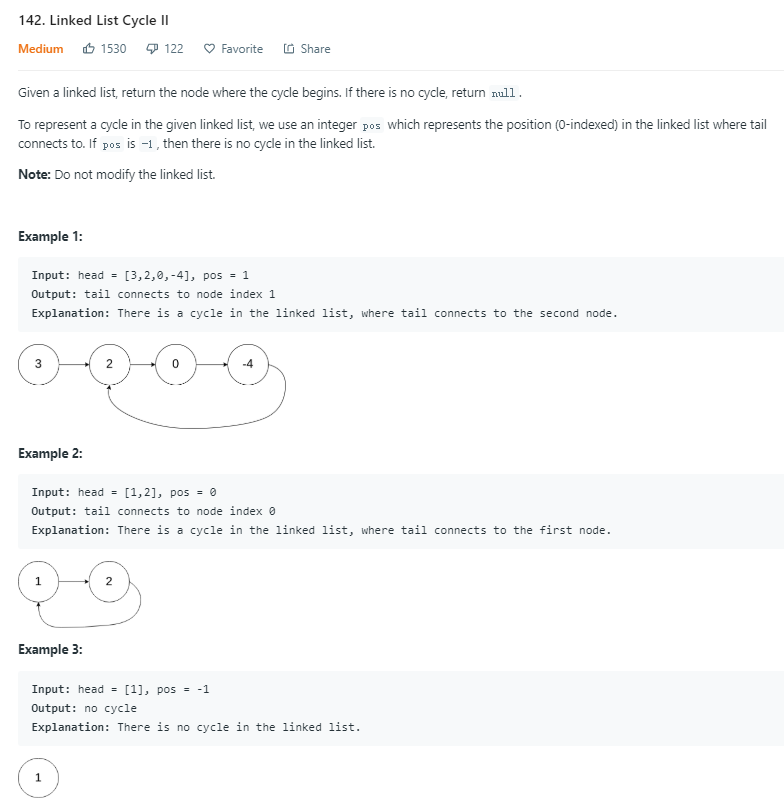

思路:
解法一:快慢指针,一开始都指向头结点,快指针fast每次走两步,慢指针slow每次走1步。若链表存在环,则fast肯定会追上slow,否则链表遍历完后,返回false。
/** * Definition for singly-linked list. * struct ListNode { * int val; * ListNode *next; * ListNode(int x) : val(x), next(NULL) {} * }; */ class Solution { public: bool hasCycle(ListNode *head) { //快慢指针 ListNode* slow = head, *fast = head; while(fast && fast->next){ slow = slow->next; fast = fast->next->next; if(slow == fast) return true; } return false; } };
解法二:hashset
/** * Definition for singly-linked list. * struct ListNode { * int val; * ListNode *next; * ListNode(int x) : val(x), next(NULL) {} * }; */ class Solution { public: bool hasCycle(ListNode *head) { //hash unordered_set<ListNode*> visited; //存储访问过的结点 while(head){ if(visited.count(head)) return true; visited.insert(head); head = head->next; } return false; } };

快慢指针相遇时,让快指针位置不变,慢指针从head开始,两个指针同时开始走,都走一步,相遇的位置就是环的起点。
参考链接:https://www.bilibili.com/video/av48348861?from=search&seid=5980719733722263225
假设快慢指针meet到的时候,慢指针走的距离是a+b, 而快指针的速度是慢指针的两倍,所以快指针走的距离是2(a+b) = a+b + n(b+c)
通过最后的公式:a = (n-1)(b+c) + c 可知 slow从head开始走,fast从meet点开始走,每次只走一步(即与slow速度相同),则最终fast走整数个(b+c)后,加上c,可与a在cycle点相遇。

/** * Definition for singly-linked list. * struct ListNode { * int val; * ListNode *next; * ListNode(int x) : val(x), next(NULL) {} * }; */ class Solution { public: ListNode *detectCycle(ListNode *head) { ListNode* slow = head, *fast = head; while(fast && fast->next){ slow = slow->next; fast = fast->next->next; if(slow == fast){ slow = head; while(slow!=fast){ slow = slow->next; fast = fast->next; } return slow; } } return NULL; } };

思路1:二分法
class Solution { public: int findDuplicate(vector<int>& nums) { // 二分法:对要定位的“数”做二分,而不是对数组的索引做二分。 // 要定位的“数”根据题意在 1 和 n 之间,每一次二分都可以将搜索区间缩小一半 int l = 1, r = nums.size()-1; while(l < r){ int mid = (l+r)/2; int cnt = 0; for(int num : nums){ if(num <= mid) cnt++; } if(cnt <= mid) l = mid+1; else r = mid; } return l; } };
思路2:快慢指针 https://www.bilibili.com/video/av62810942/
class Solution { public: int findDuplicate(vector<int>& nums) { // 转化为找一个链表的环的起点位置 => 快慢指针 // 快指针每次移动2,慢指针移动1,当它们相遇时: // 把慢指针移回开头,再同时以1前进,最后两个指针相遇的位置即为环的起点位置 int fast = 0, slow = 0; //快慢指针指向数组的索引 do{ fast = nums[nums[fast]]; slow = nums[slow]; }while(fast!=slow); slow = 0; while(fast != slow){ fast = nums[fast]; slow = nums[slow]; } return slow; } };